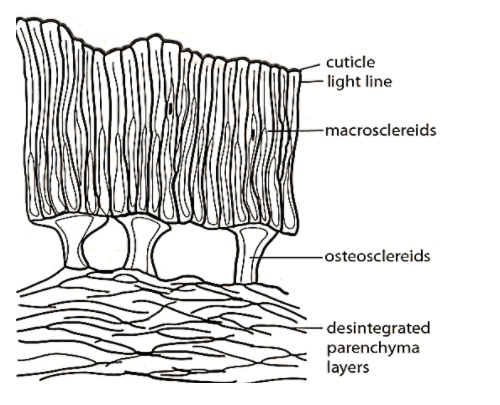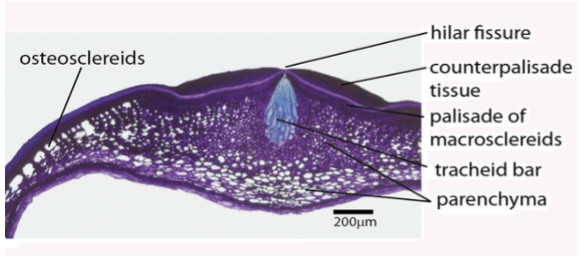
The types of sclereids present in the seed coat of the pulses, known as
A. Macrosclereids.
B. Astrosclereids.
C. Both of the above.
D. None of the above.
Answer
582.6k+ views
Hint: Seed coat of pulses (legumes) contain slightly elongated and columnar or rod-shaped cells that as whole form a palisade like outer layer.
Complete answer: Sclereids are part of the sclerenchyma tissue (reduced form of sclerenchyma) and exhibit a wide range of shapes and sizes.
They are present in several tissues of the plant, namely, the periderm, the cortex, the pith, the xylem, and also in the phloem.
Along with these structures they form a major part of fruits giving them the unique texture, and also constitute the hard shell of nuts and the outer coating in many seeds.
Testas i.e. seed coats of many plants, especially leguminous plants, are made up of two layers of macrosclereids.
Macrosclereids are elongated in shape. These cells are basically responsible for restricting the water uptake by hard seeded legumes. There is a visible light line present in a continuous line just beneath the outer surface of the macrosclereids in some legume seed coats. It is essentially due to the optical refraction properties possessed by these macro sclereid cells. Astrosclereids are another type of sclereids and have been found in the floating leaves of water lily. They are branched, pointed, and often star-shaped (hence the name astrosclereid). Given below is a clear diagram showing the arrangement of the macrosclereids in the seed coat of a legume.


So, the correct answer is A. Macrosclereids.
Note: These elongated sclereids are also referred to as ‘Malpighian cells’ after the pioneering Italian 17th century plant anatomist, Marcello Malpighi.
Complete answer: Sclereids are part of the sclerenchyma tissue (reduced form of sclerenchyma) and exhibit a wide range of shapes and sizes.
They are present in several tissues of the plant, namely, the periderm, the cortex, the pith, the xylem, and also in the phloem.
Along with these structures they form a major part of fruits giving them the unique texture, and also constitute the hard shell of nuts and the outer coating in many seeds.
Testas i.e. seed coats of many plants, especially leguminous plants, are made up of two layers of macrosclereids.
Macrosclereids are elongated in shape. These cells are basically responsible for restricting the water uptake by hard seeded legumes. There is a visible light line present in a continuous line just beneath the outer surface of the macrosclereids in some legume seed coats. It is essentially due to the optical refraction properties possessed by these macro sclereid cells. Astrosclereids are another type of sclereids and have been found in the floating leaves of water lily. They are branched, pointed, and often star-shaped (hence the name astrosclereid). Given below is a clear diagram showing the arrangement of the macrosclereids in the seed coat of a legume.


So, the correct answer is A. Macrosclereids.
Note: These elongated sclereids are also referred to as ‘Malpighian cells’ after the pioneering Italian 17th century plant anatomist, Marcello Malpighi.
Recently Updated Pages
Why are manures considered better than fertilizers class 11 biology CBSE

Find the coordinates of the midpoint of the line segment class 11 maths CBSE

Distinguish between static friction limiting friction class 11 physics CBSE

The Chairman of the constituent Assembly was A Jawaharlal class 11 social science CBSE

The first National Commission on Labour NCL submitted class 11 social science CBSE

Number of all subshell of n + l 7 is A 4 B 5 C 6 D class 11 chemistry CBSE

Trending doubts
Differentiate between an exothermic and an endothermic class 11 chemistry CBSE

10 examples of friction in our daily life

One Metric ton is equal to kg A 10000 B 1000 C 100 class 11 physics CBSE

Difference Between Prokaryotic Cells and Eukaryotic Cells

State the laws of reflection of light

Explain zero factorial class 11 maths CBSE




